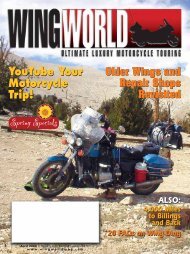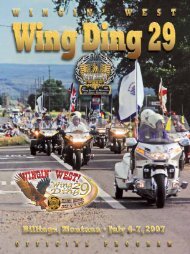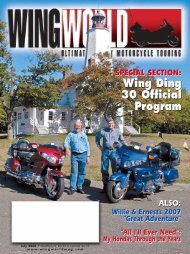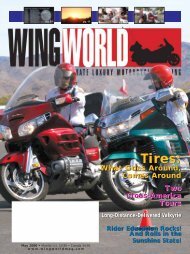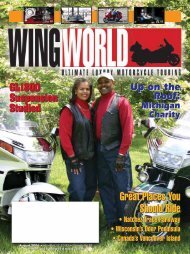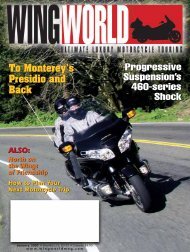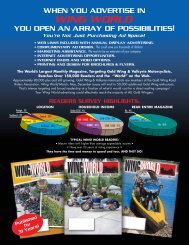to view pdf file of current issue - Wing World Magazine Archives
to view pdf file of current issue - Wing World Magazine Archives
to view pdf file of current issue - Wing World Magazine Archives
You also want an ePaper? Increase the reach of your titles
YUMPU automatically turns print PDFs into web optimized ePapers that Google loves.
B y S t u O l t m a n • S e n i o r T e c h n i c a l E d i t o rMo<strong>to</strong>rcycles have come a long way in the past hundred years.Many <strong>current</strong> riders may not realize that the mo<strong>to</strong>rcycle was oncethe preferred method <strong>of</strong> personal transportation, both in the U.S.and in Europe, before mass production <strong>of</strong> au<strong>to</strong>mobiles becameprevalent.John & Melinda’s wedding trip <strong>to</strong> Vegas highlighted some <strong>of</strong> the first system’s shortcomings.Commonly referred <strong>to</strong> as two wheels,an engine, and a place <strong>to</strong> sit, a mo<strong>to</strong>rcyclewas once no more than a bicyclewith a small engine bolted in and the rearwheel driven by a leather strap. Straps gaveway <strong>to</strong> chains, electrical units replacedkerosene headlamps, and someone eveninvented a way <strong>to</strong> recover the oil and recirculateit through the engine rather than allowingthe valve’s exposed rocker arms <strong>to</strong> fling it in<strong>to</strong>the air.But mass production <strong>of</strong> the au<strong>to</strong>mobileeventually brought prices down <strong>to</strong> the pointthat most folks sought the relative comfort <strong>of</strong>a car, especially after cars had been equippedwith windscreens, <strong>to</strong>ps, and windows. And itwas at that point that mo<strong>to</strong>rcycles began <strong>to</strong> beseen as more <strong>of</strong> a recreational vehicle than anecessity. With notable exceptions, mo<strong>to</strong>rcycleinnovation slowed, while au<strong>to</strong>mobile technologyflourished.From the earliest days <strong>of</strong> radio, car enthusiastsbegan adapting household radio equipmentfor use in their cars. But as the carbecame more reliable and more prevalent,folks began spending a lot more time in them.By 1930, a few visionary companies saw a marketfor dedicated au<strong>to</strong>mobile radios, and thecar radio was born. Galvin Corporation introducedtheir Mo<strong>to</strong>rola model 5T71 in 1930.Blaupunkt and Crossley followed in 1932 and’33. After that, it was just a matter <strong>of</strong> makingthe radios work and sound better, with morefunctionality and ease <strong>of</strong> use. 45-rpm recordplayers were introduced in 1956, followed byreel-<strong>to</strong>-reel tape, compact cassette, 8-track,and so on. The wide array <strong>of</strong> audio and videoequipment available <strong>to</strong> distract <strong>to</strong>day’s driversis as<strong>to</strong>unding.Mo<strong>to</strong>rcycles? By 1970, most were still twowheels, an engine, and a place <strong>to</strong> sit.Baby Boomers Change the IndustryCertainly, there were a few hardy soulswho regularly <strong>to</strong>ured long distances on theirmo<strong>to</strong>rcycles in the earlier years, but theadvent <strong>of</strong> larger and more comfortable mo<strong>to</strong>rcyclescoming from Japan in the 1970s causeda new type <strong>of</strong> rider <strong>to</strong> emerge. And as happenedduring the migration <strong>of</strong> early riders <strong>to</strong>au<strong>to</strong>mobiles, these new riders began migrating<strong>to</strong> the comfort and convenience that allowedthem <strong>to</strong> travel longer distances.Also as with au<strong>to</strong>mobiles, some enthusiastsin the early 1970s began adapting audio equipment<strong>to</strong> mo<strong>to</strong>rcycles. This was helped alongwhen Craig Vetter introduced the Windjammerfairing with its sturdy structure andinterior s<strong>to</strong>rage capability. Virtually everymo<strong>to</strong>rcycle sold since then with a framemounted fairing, including the GL1800, bears astriking resemblance <strong>to</strong> that original Windjammerdesign.One <strong>of</strong> those early enthusiasts was a youngman living in Tucson, Arizona, named JohnLazzeroni. John and his new bride Melinda (picturedin front <strong>of</strong> their house in Tucson justafter the wedding) decided <strong>to</strong> ride that ’78<strong>Wing</strong> <strong>to</strong> Las Vegas the next day. It had J&M’sfirst “system” installed—a PanasonicAM/FM/CB radio with hand mic for the CBand only external speakers. John couldn’t talkwith Melinda, and Melinda couldn’t hear theradio. And so began John and Melinda’s quest<strong>to</strong> develop an in-helmet system for music, CB,and intercom.They had two requirements. First, theywanted <strong>to</strong> listen <strong>to</strong> broadcast radio. And second,they wanted <strong>to</strong> be able <strong>to</strong> talk <strong>to</strong> their fellow“<strong>Wing</strong>ers” and each other. Early effortsinvolved installing Radio Shack speakers in<strong>to</strong>homemade enclosures and inserting them in<strong>to</strong>their helmets. Continual experimenting withspeakers allowed them <strong>to</strong> improve the audioquality, but they also wanted <strong>to</strong> be able <strong>to</strong>transmit on the CB without the distraction <strong>of</strong>a hand-held microphone.That became a realitywhen they discovered how <strong>to</strong> get the helmetmicrophone input in<strong>to</strong> the CB radio.Intercom then became a possibility—first fortheir own bike, then commercially as the productproved itself. After introduction <strong>of</strong> theirMarch 2009 59



